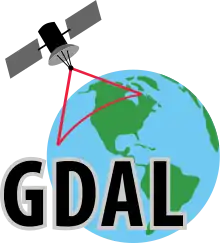GDAL
GDAL (Geospatial Data Abstraction Library) est une bibliothèque libre permettant de lire et de traiter un très grand nombre de format d'images géographiques[3] (notamment GeoTIFF et ECW) depuis des langages de programmation tels que C, C++, C sharp / .Net, Java, Ruby, VB6, Perl, Python[4], ou encore le langage statistique R[5]. Un sous-ensemble de cette bibliothèque est la bibliothèque OGR permettant d'accéder à la plupart des formats courants de données vectorielles[6] (à l'exception notable d'AutoCAD).

| Développé par | Open Source Geospatial Foundation |
|---|---|
| Dernière version | 3.5.1 ()[1] |
| Dépôt | github.com/OSGeo/GDAL |
| Écrit en | C |
| Système d'exploitation | Type Unix |
| Environnement | Microsoft Windows, GNU/Linux, BSD |
| Formats lus | ESRI Arc/Info ASCII Grid (d), ADRG General Information File (d), ADRG Transmittal Header File (d), ESRI Arc/Info Binary Grid (d), Maptech KAPP image file, version 3.0 (d), Maptech BSB documentation file, version 3.0 (d), Binary Terrain, version 1.3 (d), RADARSAT-1 CEOS SAR Data File (d), Digital Image Map, version 1 (d), Digital Image Map, version 2 (d), Portable Network Graphics, Portable pixmap, Raster Product Format Table of Contents File (d), ARC Standard Raster Product (d), UTM/UPS Standard Raster Product (d), DWG, Integrated TOPSAR Data (d), Bathymetry Attributed Grid (en), Windows bitmap, Digital Terrain Elevation Data Level 0 (d), Digital Terrain Elevation Data Level 1 (d), Digital Terrain Elevation Data Level 2 (d), BIL/BIP/BSQ Header File (d), GIF, GeoTIFF, TIFF, JPEG File Interchange Format (JFIF), JP2 (d), MrSID (en), National Imagery Transmission Format, version 1.0 (d), National Imagery Transmission Format, version 1.1 (d), National Imagery Transmission Format, version 2.0 (d), National Imagery Transmission Format, version 2.1 (d), Shapefile index file (d), Geography Markup Language et World file |
| Formats écrits | ESRI Arc/Info ASCII Grid (d), ADRG General Information File (d), ADRG Transmittal Header File (d), Binary Terrain, version 1.3 (d), Portable Network Graphics, Portable pixmap, Windows bitmap, Digital Terrain Elevation Data Level 0 (d), Digital Terrain Elevation Data Level 1 (d), Digital Terrain Elevation Data Level 2 (d), BIL/BIP/BSQ Header File (d), GIF, GeoTIFF, TIFF, JPEG File Interchange Format (JFIF), JP2 (d) et National Imagery Transmission Format, version 2.1 (d) |
| Langues | anglais |
| Type | Bibliothèque |
| Licence | X/MIT[2] |
| Site web | www.gdal.org |
La version binaire inclut de nombreux utilitaires de conversion et de transformation et de reprojection pour traiter directement les photos ou les vecteurs.
GDAL/OGR fait partie des projets de la Fondation Open Source Geospatial[7].
Cette bibliothèque est un des piliers des systèmes d'informations géographique libres, car elle permet d'assurer la compatibilité avec de nombreux systèmes commerciaux reposant sur des formats propriétaires tout autant que sur les normes de l'Open Geospatial Consortium.
Logiciels utilisant GDAL/OGR
Un nombre important de logiciels font appel à cette bibliothèque[8], dont :
Notes et références
- « GDAL 3.5.1 », (consulté le )
- (en) « Licence GDAL/OGR » (consulté le )
- (en) « GDAL Raster Formats » (consulté le )
- (en) « Python, GDAL: Geospatial Data Abstraction Library » (consulté le )
- (en) « rgdal: Bindings for the Geospatial Data Abstraction Library » (consulté le )
- (en) « OGR Vector Formats » [archive du ] (consulté le )
- (en) « OSGeo GDAL/OGR Info Sheet » (consulté le )
- (en) « Software Using GDAL » (consulté le )
Voir aussi
Article connexe
Liens externes
- Portail de l’information géographique
- Portail des logiciels libres